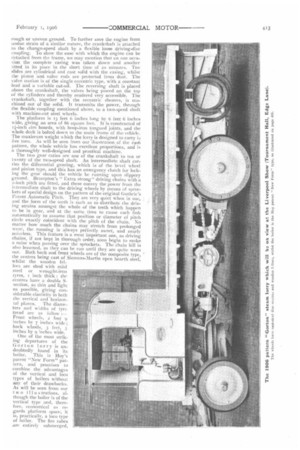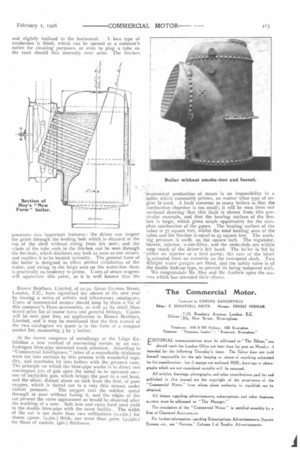A New Steam Lorry.
Page 8

Page 9

Page 11

If you've noticed an error in this article please click here to report it so we can fix it.
The " Gorton " Vehicles are now' Ready for Delivery.
Beyer, Peacock and Company, Ltd., of Gorton Foundry, Manchester, the wellknown loomcaive builders, is the latest company to enter the lists of steam lorry manufacturers. The "Gorton" lorry is the practical result oi exacting tests which have been made with two experimental steam wagons and extended over a period of several months. During the trials made with the two wagons mentioned above, the whole system was put to the most severe work which could be found for the vehicles, and the roughest Lancashire roads were purposelypicked out to show any weak points in their design. Those of our readers who are conversant with the rough parts of this county will acknowledge the completeness of the tests made, and the consequent suitability of the vehicle for the most trying work which it can be called upon to de. The Gorton lorry has a number of new but well-tried features, and it can be adapted to a variety of purposes by changing the body portion.
Special attention has been paid to all details connected with the front axle and steering arrangements. The axle is formed of a stiff 1i-section steel gii-der, with case-hardened sockets secured at each end, and these carry pivoted trunnions fitted with I loy's patent " safety " steering gear of the Ackermann type. The steering arms are governed by a screwed rod, and a nut wheel, which is carried on the axle itself, thus forming a positive lock. In this way all strains, both from the actual steering or from shocks due to travelling over uneven roads, are contained in the axle itself, and not transmitted to the steering wheel, a telescopic clutch arrangement admitting full deflection of the springs without interfering with the directional control. The disposition of the various parts connected with the steering gear can be very clearly seen in the illustration_ The engine is of the simple type, with two cylinders, each 5 inches stroke by 31 inches diameter, but a compounded form can be supplied. The engine is enclosed, and built completely independent of the lorry; it is attached to the frame by three bolts, so that it can be unslung in a few minutes and replaced by a spare one if this should be necessary at any time. It will be observed that three-point suspension is employed, and this ensures freedom from any risk of cross-winding when the wagon is running over rough or uneven ground. To further save the engine from undue strain of a similar nature, the crankshaft is attached to the change-speed shaft by a flexible loose driving-disc coupling. To show the ease with which the engine can be detached from the frame, we may mention that on one occasion the complete casing was taken down and another lined in its place in the short time of 20 minutes. Inc slides are cylindrical and cast solid with the casing, whilst the piston and valve rods are protected from dust. 1 he valve !notion is of the single eccentric type, with a constant lead and a variable cut-off. The reversing shaft is placed above the crankshaft, the valves being placed on the top of the cylinders and thereby rendered very accessible. The crankshaft, together with the eccentric sheaves, is machined out of the solid. It transmits the power, through the flexible coupling mentioned above, to a two-speed shaft with machine-cut steel wheels.
The platform is 13 feet 6 inches long by 6 feet 6 inches wide, giving an area of 86 square feet. It is constructed of
1:1-inch elm boards, with hoop-iron tongued joints, and the whole deck is bolted down to the main frame of the vehicle. The maximum weight which the lorry is designed to carry is five tons. As will be seen from our illustration of the too6
pattern, the whole vehicle has excellent proportions, and is a thoroughly well-designed and practical machine.
The two gear ratios are one of the crankshaft to ten or twenty of the two-speed shaft. An intermediate shaft carries the differential gearing, which is of the bevel wheel and pinion type, and this has an emergency clutch for locking the gear should the vehicle be running upon slippery ground. l3rampton's " Extra strong" driving chains with a 2-inch pitch are fitted, and these convey the power from the intermediate shaft to the driving wheels by means of sprockets of special design on the pattern of the original Guthrie's Patent Automatic !'itch. They are very quiet when in use, amid the form of the teeth is such as to distribute the driving strains amongst the whole of the teeth which happen to be in gear, and at the same time to cause each link automatically to assume that position or diameter of pitch circle exactly coincident with the pitch of the chain_ No matter how much the chains may stretch from prolonged wear, the running is always perfectly sweet, and nearh noiseless. This feature is a most important one, as driving chains, if not kept in thorough order, soon begin to make a noise when passing over the sprockets. The chain hill is also lessened, as they can be run until they are quite worn out. Both back and front wheels are of the composite type, the centres being cast of Siemens-Nlartin open hearth steel, whilst the wooden fel
ines are shod with mild steel or wrought-iron tyres, t inch thick : the centres have a double 8 section, as thin and light as possible, giving considerable elasticity in both the vertical and horizon tal planes. The dianie ters and widths of tyre
tread are as follow :Front wheels, 2 feet 9 inches by 7 inches wide ; back wheels, 3 feet, 3 inches by 9 inches wide.
One of the most striking departures of the Gorton lorry is un doubtedly found in its boiler. This is Hoy's patent "New Form" pat tern, and promises to combine the advantages of the vertical and loco types of boilers without any of their drawbacks. As will be seen from our two illustrations, :41though the boiler is of the vertical type and, therefore, economical as regards platform space, it is, practically, a loco type of boiler. The fire tubes are entirely submerged, and slightly inclined to the horizontal. A loco type of smoke-box is fitted, which can be opened at a moment's notice for cleaning purposes, or even to plug a tube on the road should this necessity ever arise. The fire-box possesses two important features : the driver can inspect the grate through the feeding hole which is situated at the top of the shell without rising from his seat; and the whole of the tube ends in the fire-box can be seen through the fire-hole, which discloses any leak as soon as one occurs, and enables it to be located instantly. The general form of the boiler is designed to effect perfect circulation of the water, and owing to the large area on the water-line there is practically no tendency to prime. Users of steam wagon:, will appreciate this point, as it is well known that the economical production of steam is an impossibility in a boiler which constantly primes, no matter what type of engine is used. A fault common to many boilers is that the combustion chamber is too small; it will be seen from our sectional drawing that this fault is absent from this particular example, and that the heating surface of the firebox is large, which gives ample opportunity for the complete combustion of the gases. The heating surface of the tubes is 77 square feet, whilst the total heating area of the rubes and the fire-box is equal to 95 square feet. The working pressure is zoolb. on the square inch. The regulator, blower, injector, water-lifter, and the stoke-hole are within easy reach of the driver's left hand. The biller is fed by either an injector or a feed pump; the ram of the latter is actuated from an eccentric on the two-speed shaft. Two Flinger water gauges are fitted, and the safety valve is of the double lock-up type, to prevent its being tampered with.
We congratulate Mr. Hoy and Mr. Guthrie upon the success which has attended their efforts.
Brown Brothers, Limited, of 22-30, Great Eastern Street, London, E.C., have signalised the advent of the new year by issuing a series of artistic and informatory catalogues. Users of commercial motors should keep by them a. list of this company's Duco accessories, as well as its retail illustrated price list of motor tyres and general fittings. Copies will be sent post free, on application to Brown Brothers, Limited, and it may be mentioned that the first named of the two catalogues we quote is in the form of a compact pocket list, measuring 5 by 3 inches.
At the recent congress of metallurgy at the Liege Exhibition a new method of connecting metals by an oxyhydrogen blow-pipe attracted much attention. According to "Commercial Intelligence," tubes of a remarkable thickness were cut into sections by this process with wonderful rapidity, and manholes let into boilers with the greatest ease. The principle on which the blow-pipe works is to direct two convergent jets of gas upon the metal to ne operated on— one of oxyhydrie gas, which brings the part to a red heat, and the other, distant about an-inch from the first, of pure oxygen, which is darted out in a very thin stream under
violent pressure. The oxygen cuts the red-hot metal through at once without fusing it, and the edges of the cut present the same appearance as would be observed after the working of a saw. Soft iron and extra hard steel yield to the double blow-pipe with the same facility. The width of the cut is not more than two millimetres (t-izin.) for sheets ismm. (3-5in.) thick, nor more than 3mm. (3-25in.) for those of 100MM. (4in.) thickness.




















